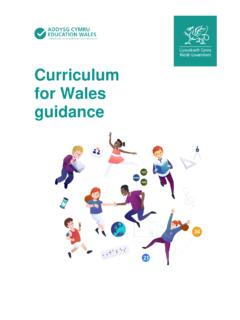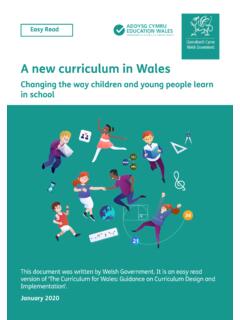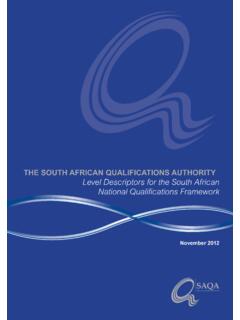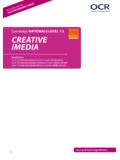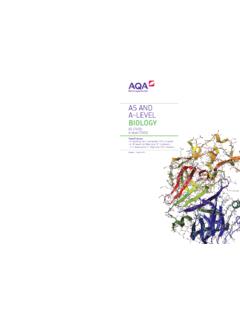Transcription of National Literacy and Numeracy Framework
1 National Literacy and Numeracy Framework To support schools in introducing the National Literacy and Numeracy Framework Information Information document no: 120/2013. Date of issue: March 2013. National Literacy and Numeracy Framework Audience Primary, secondary and special schools in Wales; Welsh local authorities and regional education consortia; unions; various organisations that have an interest in Literacy and Numeracy ; and members of the public. Overview This information document is to accompany and help schools in Wales to implement the National Literacy and Numeracy Framework (LNF). Action None for information only. required Further Enquiries about this document should be directed to: information Foundation Phase and School Curriculum Branch Department for Education and Skills Welsh Government Cathays Park Cardiff CF10 3NQ. Tel: 029 2082 5447. e-mail: Additional This document is only available on the Welsh Government's website copies at Related National Literacy Programme (Welsh Government, 2012); National documents Numeracy Programme (Welsh Government, 2012); The Skills Framework at key stage 2: An evaluation of the impact of the non-statutory Skills Framework for 3 to 19-year-olds in Wales at key stage 2 (Estyn, 2011); The Skills Framework at key stage 3: An evaluation of the impact of the non-statutory Skills Framework for 3 to 19-year-olds at key stage 3 (Estyn, 2012); Routes for Learning routemap (Welsh Assembly Government, 2006); Assessment of 5- to14-year-old children's mathematical progress in schools in Wales (Welsh Government, 2012); Language, Literacy and Communication Skills (Welsh Assembly Government, 2008); Guidance on the teaching of writing skills (Welsh Assembly Government, 2010).
2 Developing higher-order Literacy skills across the curriculum (Welsh Assembly Government, 2010). This document is also available in Welsh. Digital ISBN 978 0 7504 9260 7. Crown copyright 2013. WG18281. Contents Introduction 2. Purpose, aims and features of the National Literacy and Numeracy Framework (LNF) 4. Key aims 4. Key features 4. LNF implementation and support 6. Guidance and training materials 6. National support programme (NSP) 6. Timetable 6. The National curriculum 7. The LNF and the whole curriculum 7. The LNF and the review of curriculum and assessment 7. About the LNF 8. Structure of the LNF 8. Supporting progression for all learners 9. The LNF in the Foundation Phase 9. The LNF in Welsh-medium schools 10. Learners with additional learning needs (ALN) 11. Learners for whom English is an additional language (EAL) 11. Learners with dual Literacy 12. Assessment against the LNF 13. The LNF and the National tests 15. Overview of the Literacy component of the LNF 16.
3 The curriculum connection 16. Progression in Literacy 16. The Literacy strands 17. Overview of the Numeracy component of the LNF 20. The curriculum connection 20. Progression in Numeracy 20. The Numeracy strands 21. Appendix 1: Glossary of Literacy terms (to accompany the English-medium Literacy component) 24. Appendix 2: Glossary of Literacy terms (to accompany the Welsh-medium Literacy component) 35. Appendix 3: Glossary of Numeracy terms 46. Appendix 4: Related documents and links 50. Introduction The Minister for Education and Skills has made raising standards of Literacy and Numeracy in schools a priority. In his keynote address Raising Schools Standards' on 29 June 2011, to the Institute of Welsh Affairs, he announced the intention to introduce a new National Literacy and Numeracy Framework (LNF) for all learners aged 5 to 14. Literacy and Numeracy skills are absolutely essential in order for young people to reach their potential whether they are planning to enter further or higher education or the employment market.
4 The National Literacy Programme and the National Numeracy Programme set out the actions the Welsh Government intends to implement to improve Literacy and Numeracy standards in Wales. The plans for a statutory National Framework and for a system of National testing are integral to both programmes. The LNF has been developed to help achieve our aims that the children of Wales are able to develop excellent Literacy and Numeracy skills during their time in school. The current National curriculum introduced from 2008 seeks to weave skills development throughout the curriculum and is, therefore, underpinned by the non-statutory Skills Framework for 3 to 19-year-olds in Wales (Welsh Assembly Government, 2008) which covers developing thinking, communication, ICT and number. The Estyn report The Skills Framework at key stage 2: An evaluation of the impact of the non statutory Skills Framework for 3 to 19-year-olds in Wales at key stage 2 in July 2011 and similar report for Key Stage 3 in May 2012 found that the skills Framework had not been effective.
5 The LNF will replace the communication and number element of the non-statutory skills Framework . It will be a statutory curriculum requirement from September 2013, with assessment against the LNF becoming a statutory requirement from September 2014. The LNF is based on research into effective teaching, assessment, recording and reporting practice, and the success of similar international systems. It was developed in partnership with an National Literacy and Association of Directors of Education in Wales (ADEW) advisory Numeracy Framework panel consisting of local authority Literacy and Numeracy advisers. January 2013 Consultation on the LNF took place between 11 June and Information document no: 120/2013. 12 October 2012. The results of the consultation have informed the development of the final version of the LNF. 2. The LNF has been developed as a curriculum planning tool for schools that will provide a continuum of development, clearly setting out annual expected outcomes in Literacy and Numeracy .
6 National Literacy and Numeracy Framework January 2013. Information document no: 120/2013. 3. Purpose, aims and features of the National Literacy and Numeracy Framework (LNF). The LNF is first and foremost a curriculum planning tool that supports all teachers to embed Literacy and Numeracy in their teaching of the curriculum. Our aim is to support all teachers to see themselves as having an important role in developing the Literacy and Numeracy skills of their learners. All schools currently have curriculum planning arrangements and these will need to be adapted to support cross-curricular planning using the LNF. While we acknowledge that skills development for younger learners, in particular, may be more erratic, effective cross-curriculum planning for skills and a Framework for continued development is important for all learners. Key aims The key aims of the LNF are to: help teachers of all subjects to identify and provide opportunities for learners to apply Literacy and Numeracy across the curriculum, and is broken down by year group describe, with precision, the annual National expectations for Literacy and Numeracy for learners 5 14, and progression indicators for learners with additional learning needs help determine learner progress in Literacy and Numeracy and provide annual reports to parents/carers based on teacher assessment so that teachers, learners and parents/carers are all clear how learners are progressing and what are the next steps.
7 There will be no National level data collection. Key features The key features of the LNF include the following. Through expectation statements, the LNF sets out the skills we expect learners to develop throughout their time in school, from ages 5 to 14, and is broken down into year groups. The LNF is split into components for Literacy and Numeracy , which are in turn split into strands. The Literacy strands are: oracy across the curriculum, reading across the curriculum and writing across the curriculum. National Literacy and The Numeracy strands are: developing numerical reasoning, Numeracy Framework using number skills, using measuring skills and using data skills. January 2013. Information document no: Each strand is further split into elements, with Literacy also broken 120/2013 down into aspects. 4. The Literacy component is available in both English and Welsh. The expectations in both English and Welsh are similar, with a few distinctive elements in the Welsh Literacy component, reflecting the unique requirements of the Welsh language.
8 In addition to being a curriculum planning requirement, the LNF. is also to be used by teachers for formative assessment. The LNF will be used to inform teachers' assessment of learners'. Literacy and Numeracy skills and will be reported annually to parents/carers. There will be no National level data collection. National Literacy and Numeracy Framework January 2013. Information document no: 120/2013. 5. LNF implementation and support The LNF will be fully supported by a comprehensive range of online guidance and training materials and by a National programme of support. Guidance and training materials A suite of guidance and training materials are being developed to help schools and teachers implement the LNF curriculum planning guidance, assessment guidance, training materials and classroom materials. National support programme (NSP). A programme of support is being developed to provide hands-on support and training for all schools and teachers in implementing the LNF.
9 This is in addition to the training and guidance materials currently being developed. Timetable January 2013: LNF and supporting documents published. January 2013: curriculum planning guidance and training materials issued. Spring term 2013: National support programme begins. September 2013: LNF introduced on a statutory basis. September 2013: assessment guidance and classroom practice materials issued. National Literacy and September 2014: assessment against Numeracy Framework LNF introduced on a statutory basis. January 2013. Information document no: 120/2013. 6. The National curriculum The LNF and the whole curriculum The LNF is a curriculum planning tool, which builds on the current good practice that exists in many schools. It aims to help bring about coherent approaches to developing Literacy and Numeracy across the curriculum, informing teachers of all subjects how they can provide opportunities for learners to apply Literacy and Numeracy across the curriculum.
10 Therefore, in both primary and secondary schools, planning for developing Literacy and Numeracy skills needs to be truly cross-curricular rather than focused on English, Welsh and mathematics lessons. The National curriculum implemented from 2008 introduced a skills-based approach to the curriculum designed to ensure that skills were developed across the curriculum. It is underpinned by the non-statutory skills Framework which covers thinking, communication, ICT and number skills. The LNF builds on the expectations set out in the skills Framework . However, it will be a statutory curricular requirement under section 108(9) of the Education Act 2002. It will also provide greater clarity for teachers to assess and track skills progression. The LNF will replace the communication and number components of the non-statutory skills Framework . The thinking and ICT skills components remain in place to guide schools on these important skills and these will be looked at separately for future guidance.



